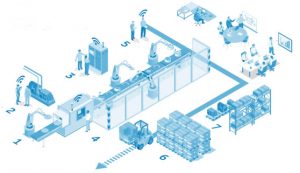[ad_1]
 The top strategic objectives in the manufacturing industry have remained consistent for years, with many centered on serving customers.
The top strategic objectives in the manufacturing industry have remained consistent for years, with many centered on serving customers.
Industrial companies want to deliver customers high quality products, on time, at a globally competitive cost. They also want to be able to flex production capabilities up and down as needed to quickly introduce new products to the marketplace.
Pairing physical assets with intelligent gateways to gather, analyze and communicate data is driving enormous new efficiencies in manufacturing and business operations.
New operational efficiencies enabled by IoT are generating significant returns in manufacturing.
We see four pillars for IoT-enabled, smart factory optimization:
- Connectivity: With the ability to connect to everything it is important to determine required data, and the processes and operations needing improvement. Then collect and curate relevant structured and unstructured data, across systems.
- Cloud: Accelerate implementation and time to value via cloud data centers located globally to provide a secure, scalable, and flexible environment.
- Analytics: Apply advanced analytics to gain new insights from manufacturing data. Dashboards visualize data patterns to quickly assess equipment performance.
- Application Development: Accelerate innovation and deliver high-quality products faster with agile-ready software development solutions
- These four pillars are transforming manufacturing through providing greater intelligence, higher cognition, and smarter resources that enable organizations to thrive. In addition, this helps to drives cost savings and the ability to improve areas, including asset visibility and reliability, product quality and traceability, and resource efficiency and safety.
Follow these five best practice steps when planning your project implementation.
1. Establish a project success model
Choose an initial project that proposes a solution with a strong project delivery methodology to enrich and complement business processes. A strong recipe for success is to understand how other projects have missed the mark. Build the underpinnings of the organization, the people and the process so that the technology can be delivered in a way that provides specific value. Consider these key project goals to ensure your success:
- Start with a well-defined problem to attack
- Get support by stakeholders who have the right expertise to get the problem solved
- Determine ownership within your IT and OT organizations
- Establish the ROI value and key project milestones
- Focus on projects that can transform both adoption of new technologies as well as improvement of business processes
2. Build on a strong foundation of data
Determine what data you need and which processes and operations you want to improve.
Collect and curate the data that you already have readily available, then add sensors to bring in real-time data that you currently do not have. Real-time insights give context through integration with systems that contain master records about equipment, such as the make and model, when it was purchased, when it was put into service, as well as historical information about repairs and maintenance. This valuable context provides organizations with a greater level of understanding about how things operate throughout the factory.
By linking these types of data sources together with IoT data from devices and sensors, you can gain even greater insight into their performance and health.
3. Gain contextual visibility into operations
Establish real-time visibility into all that’s happening – where are your things, what alerts were triggered, how is the asset performing? Intelligent gateways can provide a contextual view across all assets and devices, as well as a map of locations, historical logs, reports, health and condition.
All of this data enables users to tailor real-time visualizations to fit their specific needs and functional responsibilities. With granular and contextual data, manufacturers can apply network policies throughout the extended production process. Additionally, actionable data can be shared with the appropriate personnel, vendors, and partners, to inform and improve decision-making.
4. Apply rules and analytics to identify issues
Rules and analytics of all types can monitor the ongoing conditions of equipment, operations and even the surrounding environment. Known conditions, such as normal operating or expected usage patterns, can be reflected in rules that trigger when certain conditions are breached.
However, there are challenges in terms of the volume and variety of the devices and data which traditional rules engines are not designed to handle. Choose a gateway that delivers a highly scalable, parallel processing rules engine and an intuitive, visual rules editor that is simple to manage. For more complex situations, advanced predictive analytics can also help organization gain new insights from IoT data.
5. Automate actions when issues arise
IoT demands an increasing amount of automation – there are simply too many sensors and devices and too much data to process. Automating responses to abnormal conditions and issues is critical.
Find an IoT solution with an action engine that can do basic tasks, such as send an SMS message or an email when a rule is triggered, but also allows you to take actions through external systems. This combination provides a closed loop response to issues in the operational environment, while providing traceability from the sensor data to the asset to the response all through a flexible automated process.
You can read more on IoT-enabled factory optimization (PDF).
Dermot O’Connell, executive director and general manager, EMEA, Dell EMC OEM
[ad_2]
Source link
